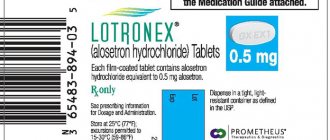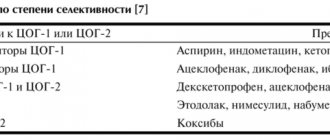Latran, 5 pcs., 4 ml, 2 mg/ml, solution for intravenous and intramuscular administration
INSTRUCTIONS for using LATRANUM
APPROVED:
Pharmacological State Committee of the Ministry of Health of the Russian Federation on March 23, 2000 in return
instructions approved on April 11, July 6, 1995, March 28, 1996, 29
July 1998
Latran (ondansetron) - 9-methyl-3-(2-methyl-1H-imidazol-1-ylmethyl)-1,2,3,9-tetrahydrocarbazole-4
(H)-one hydrochloride dihydrate - white or off-white
crystalline powder. In medical practice it is used in the form of an injection solution and tablets.
Pharmacological properties
Latran is an antiemetic from the group of serotonin antagonists. Pharmacodynamics.
Selectively blocks 5-HT3 receptors of the central and peripheral nervous system, incl. in the neural centers that regulate the implementation of gag reflexes. The drug has anxiolytic activity and does not cause sedation, impaired coordination of movements or decreased activity and performance. Eliminates somatic and psychopathological symptoms of mild to moderate alcohol withdrawal syndrome.
Indications for use
Nausea and vomiting caused by X-ray or chemotherapy
antitumor drugs or exposure to ionizing radiation.
Prevention and treatment of vomiting in the postoperative period. Symptomatic
treatment of alcohol withdrawal syndrome (especially mild and moderate
degree of severity).
Directions for use and doses
Latran solution 0.2% for injection is administered intravenously, Latran tablets are taken orally. For adults, Latran solution 0.2% is first administered once intravenously at a dose of 0.008–0.016 g over 15 minutes immediately before chemotherapy. After 2 hours, start taking Latran tablets orally in a single dose of 0.008 g every 8 hours, but not more than 5 days. For children over 4 years of age, Latran solution 0.2% is administered once intravenously for 15 minutes immediately before chemotherapy at a dose determined at the rate of 0.005 g of the drug per 1 m2 of the child’s body surface, after which Latran tablets are taken orally at 0.004 g every 8 h, but not more than 5 days. When exposed to ionizing radiation, the drug is taken orally in a single dose of 0.008 g (2 tablets) 1 hour before or immediately after radiation exposure. For the symptomatic treatment of alcohol withdrawal syndrome, a dose of 0.008 g is administered intravenously in the form of a 0.2% solution in 400 ml of hemodez, chlosol or saline. If necessary, re-administration of the drug Latran is possible.
Contraindications
Hypersensitivity, pregnancy, breastfeeding period.
Side effect
From the side of the central nervous system:
headache; rarely - transient visual disturbances and dizziness (with rapid intravenous administration), involuntary movements.
From the cardiovascular system:
chest pain, arrhythmias, bradycardia, arterial hypotension.
From the digestive system:
constipation, diarrhea, transient increase in serum transaminases.
Allergic reactions:
rarely - bronchospasm, angioedema, urticaria; in some cases - anaphylactic reactions.
Other:
urinary retention, feeling of warmth and rush of blood to the head and epigastric region.
special instructions
When used in patients with moderate and severe liver dysfunction, it is not recommended to exceed a dose of 8 mg/day.
Interaction with other drugs
Due to the fact that ondansetron is metabolized in the liver by enzymes of the cytochrome P450 system, it is possible that when used simultaneously with drugs that are inducers or inhibitors of this enzyme system, Cl and T1/2 of ondansetron change.
Release form
Solution 0.2% for injection in ampoules of 2 ml or 4 ml, 5 ampoules per box; tablets of 0.004 g, film-coated, 10 pcs. in blister packs, 1 pack in a box, or in jars of 60 or 100 pcs., or in jars of 0.5 kg.
Storage conditions
Ampoules with solution - in a place protected from light. Tablets - in a dry place, protected from light. List B.
Best before date
3 years.
Dispensed by prescription.
Manufacturer - State Enterprise SPC "Pharmzashchita", 141400, Khimki, Moscow region, Vashutinskoe highway, 11
Latran amp 2mg/ml 4ml N5 (Pharmprotection)
Intravenously, intramuscularly, orally. Cytostatic therapy: the choice of dosage regimen is determined by the emetogenicity of antitumor therapy. For adults, the daily dose is usually 8–32 mg, the following regimens are recommended: For moderately emetogenic chemotherapy or radiotherapy For highly emetogenic chemotherapy The effectiveness of Latran® can be increased by a single intravenous administration of a glucocorticoid (for example, 20 mg of dexamethasone) before the start of chemotherapy. For to prevent delayed vomiting that occurs after the first 24 hours from the start of chemotherapy, it is recommended to continue taking the drug orally in the form of tablets, 8 mg 2 times a day for 5 days. For children over 2 years of age, the drug is prescribed at a dose of 5 mg/m2 intravenously directly before starting chemotherapy, followed by oral administration at a dose of 4 mg after 12 hours; after the end of chemotherapy, it is recommended to continue treatment at a dose of 4 mg orally 2 times a day for 5 days. Prevention of postoperative nausea and vomiting: adults are given a single dose of 8 mg intravenously in a slow stream at the beginning of anesthesia, or 16 mg is prescribed orally 1 hour before the start of anesthesia. To relieve nausea and vomiting, it is recommended to administer 8 mg of the drug intramuscularly or slowly intravenously. Latran® can be administered intramuscularly into the same area of the body in a dose not exceeding 8 mg. For children, to prevent postoperative nausea and vomiting, Latran® is used exclusively parenterally in a single dose of 0.1 mg/kg (maximum up to 4 mg) as a slow intravenous injection before or after anesthesia. For the treatment of developed postoperative nausea and vomiting in children, slow intravenous administration of a single dose of 0.1 mg/kg (maximum up to 4 mg) is recommended. In Russia, there is not enough experience in using the drug for the prevention and treatment of postoperative nausea and vomiting in children under 2 years of age. When exposed to ionizing radiation, Latran® is taken orally in a single dose of 8 mg (2 tablets) 1 hour before or immediately after radiation effects. For the symptomatic treatment of alcohol withdrawal syndrome, the drug is administered intravenously at a dose of 8 mg (in the form of a solution of 2 mg/ml, 4 ml) in 400 ml of hemodez, chlosol or saline solution. If necessary, repeated administration of the drug is possible. Elderly patients do not need to change the dosage. Patients with kidney damage do not need to change the usual daily dose and frequency of administration of the drug. If the liver is damaged, the dose should be reduced to 8 mg per day. The following solutions can be used to dilute the injection solution: 0.9% sodium chloride solution; 5% glucose solution; Ringer's solution; 0.3% potassium chloride solution and 0.9% sodium chloride solution; 0.3% potassium chloride solution and 5% glucose solution.
LATRAN
Directions for use and doses
Inside.
In oncological practice, for the prevention and relief of emetic syndrome during radiotherapy and chemotherapy: Cytostatic therapy The choice of dosage regimen is determined by the emetogenicity of antitumor therapy.
For adults, the daily dose is 8-24 mg, the following regimens are recommended:
With moderate severity of the emetogenic effect of chemotherapy or radiotherapy:
Adults and children over 12 years of age are prescribed 8 mg of ondansetron 1-2 hours before the start of main therapy, followed by another 8 mg orally 12 hours later.
Children from 4 to 11 years of age are prescribed 4 mg of ondansetron 30 minutes before the start of main therapy, followed by another 4 mg orally every 8 hours.
There are no data on use in radiotherapy in children under 12 years of age.
With a high severity of the emetogenic effect of chemotherapy or radiotherapy:
The recommended dose for adults (there are no data on use in children) is 24 mg simultaneously with dexamethasone orally at a dose of 12 mg 1-2 hours before the start of chemotherapy.
To prevent late or prolonged vomiting:
Adults should continue taking the drug orally at a dose of 8 mg 2 times a day for 5 days after the end of the main therapy.
For children, the drug is prescribed at a dose of 5 mg/m2 of body surface intravenously for at least 15 minutes immediately before the start of chemotherapy, followed by 4 mg of ondansetron orally after 12 hours; It is recommended to continue treatment at a dose of 4 mg 2 times a day orally for 5 days.
In surgical practice for the prevention and relief of emetic postoperative syndrome:
Prevention of postoperative nausea and vomiting
Adults are prescribed 16 mg orally 1 hour before the start of general anesthesia.
For children, ondansetron is used only parenterally to prevent and relieve postoperative nausea and vomiting.
There is insufficient experience with the prevention and treatment of postoperative nausea and vomiting in children under 2 years of age.
When exposed to ionizing radiation, Latran® is taken orally in a single dose of 8 mg (2 tablets) 1 hour before or immediately after radiation exposure.
Elderly patients
No dose change is required.
Patients with kidney and liver damage
In case of kidney pathology, it is not necessary to change the usual daily dose and frequency of administration of the drug. In case of liver pathology, the daily dose is reduced to 8 mg.
Patients with poor metabolism of sparteine/debrisoquine No adjustment of the daily dose or frequency of ondansetron is required.
Latranum®
Inside.
Prevention and treatment of nausea and vomiting caused by cytostatic chemotherapy and radiation therapy in adults
The choice of dosage regimen is determined by the emetogenicity of antitumor therapy and may differ depending on the dose and combinations of chemotherapy and radiation therapy regimens used.
Adults
The recommended dose is 8 mg of ondansetron 1-2 hours before the start of cytotoxic chemotherapy or radiation therapy, followed by 8 mg orally every 12 hours for no more than 5 days.
For highly emetogenic chemotherapy, a single dose of oral ondansetron is 24 mg simultaneously with oral dexamethasone at a dose of 12 mg 1-2 hours before the start of chemotherapy.
After the first 24 hours after chemotherapy or radiation therapy, you can continue taking Latran® orally for no more than 5 days.
It is recommended to take Latran® orally at a dose of 8 mg 2 times a day.
Special patient groups
Elderly patients
No dose adjustment of Latran® in oral dosage form is required for elderly patients.
Patients with impaired renal function
No adjustment is required in the daily dose, dosing frequency, or route of administration of ondansetron.
Patients with liver dysfunction
In patients with moderate to severe liver dysfunction, the clearance of ondansetron is significantly reduced and the half-life is significantly increased.
In such patients, the daily dose of ondansetron should not exceed 8 mg.
Patients with poor metabolism of sparteine-debrisoquine
In patients with poor metabolism of sparteine-debrisoquine, the half-life of ondansetron is unchanged. Therefore, when ondansetron is reintroduced to such patients, its plasma concentration will not differ from that in the general population. Therefore, no adjustment of the daily dose or dosing frequency of ondansetron is required in this case.
Prevention and treatment of nausea and vomiting caused by other types of radiation exposure in adults
The drug Latran® is taken orally in a single dose of 8 mg (2 tablets) 1 hour before or immediately after radiation exposure.
Prevention and treatment of nausea and vomiting caused by cytostatic chemotherapy in children
Dose calculation based on body surface area in children aged 3 years to 18 years for the prevention and treatment of chemotherapy-induced nausea and vomiting
The drug Latran®, a solution for intravenous and intramuscular administration, can be used as a single intravenous injection at a dose of 5 mg/m2 (not more than 8 mg) immediately before chemotherapy, followed by oral administration of the drug 12 hours later. Taking the drug Latran® in oral dosage form can be continued for another 5 days after the course of chemotherapy. Dosages used for adults should not be exceeded.
Dose calculation table based on body surface area in children aged 3 years to 18 years for the prevention and treatment of chemotherapy-induced nausea and vomiting
| Body surface area | Day 1 | Day 2-6 |
| ≥ 0.6 m2 and ≤ 1.2 m2 | 5 mg/m2 IV, then 4 mg ondansetron 12 hours later | 4 mg ondansetron every 12 hours |
| > 1.2 m2 | 5 mg/m2 IV or 8 mg IV, then 8 mg ondansetron 12 hours later | 8 mg ondansetron every 12 hours |
Dose calculation based on body weight in children aged 3 years to 18 years for the prevention and treatment of chemotherapy-induced nausea and vomiting
The drug Latran®, solution for intravenous and intramuscular administration should be administered once intravenously immediately before the start of chemotherapy (see instructions for use for the drug Latran®, solution for intravenous and intramuscular administration), followed by oral administration of the drug Latran 12 hours after the start of therapy.
Taking Latran® in oral dosage form can be continued for another 5 days after the course of chemotherapy. Dosages used for adults should not be exceeded.
Weight-Based Dose Calculation Chart in Children 3 Years to 18 Years of Age for the Prevention and Treatment of Chemotherapy-Induced Nausea and Vomiting
| Body mass | Day 1 | Day 2-6 |
| > 10 kg | Up to 3 doses of 0.15 mg/kg IV every 4 hours | 4 mg ondansetron every 12 hours |
Prevention of postoperative nausea and vomiting in adults
Adults
To prevent nausea and vomiting in the postoperative period, it is recommended to take 16 mg of Latran® orally 1 hour before anesthesia.
For the treatment of postoperative nausea and vomiting, the drug Latran® is used in the dosage form of a solution for intravenous and intramuscular administration.
Special patient groups
Children aged 3 to 18 years
Studies of taking Latran® in oral dosage form for the prevention or treatment of nausea and vomiting in the postoperative period have not been conducted; for this purpose, it is recommended to use the drug Latran®, a solution for intravenous and intramuscular administration in the form of slow intravenous injections (lasting at least 30 seconds).
Elderly patients
There is limited experience with ondansetron for the prevention of postoperative nausea and vomiting in elderly patients, although ondansetron is well tolerated in patients aged 65 years and older who have received chemotherapy.
Patients with impaired renal function
No adjustment is required in the daily dose, dosing frequency, or route of administration of ondansetron.
Patients with liver dysfunction
In patients with moderate to severe liver dysfunction, the clearance of ondansetron is significantly reduced and the half-life is significantly increased.
In such patients, the daily dose of ondansetron should not exceed 8 mg.
Patients with poor metabolism of sparteine-debrisoquine
In patients with poor metabolism of sparteine-debrisoquine, the half-life of ondansetron is unchanged. Therefore, when ondansetron is reintroduced to such patients, its plasma concentration will not differ from that in the general population. Therefore, no adjustment of the daily dose or dosing frequency of ondansetron is required in this case.


